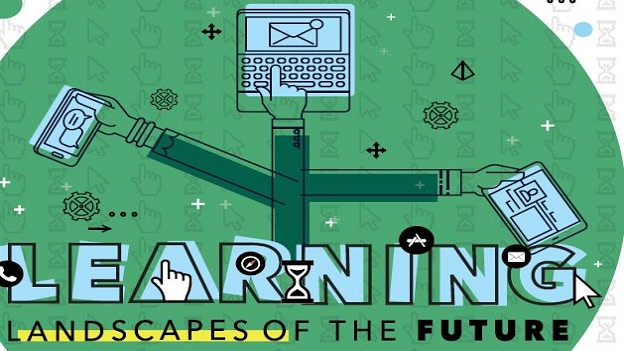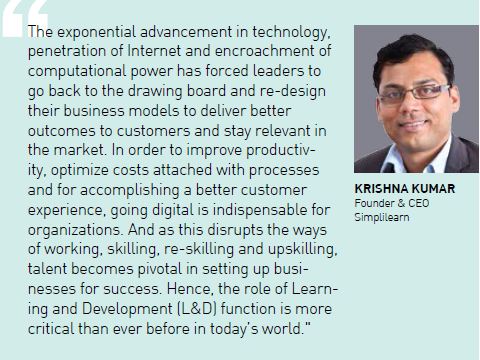Learning landscapes of the future

We are amidst uberization of the workforce. Organizations are becoming agile and so is the workforce. From liquid workforce, talent on demand, independent workers to an app-driven labor market — these are the new norms that are and will make an impact on everything — including the traditional learning models. And this is the kind of disruption we are experiencing in a hyper connected world that is driven by innovation.
So, how will IoT impact L&D professionals? What specific learning technologies will dominate and enable the Internet of Things? How can these technologies create new, innovative learning experiences for employees? How IoT may change the roles, responsibilities, and rules of running your learning organization?
In a bid to seek answers to such questions, we reached out to thought leaders in the L&D space and asked them what they think about the changes that the 4IR is generating, and what it would do to the L&D space.
The cover story also includes People Matters- Simplilearn L&D Tech study on Skill Acquisition for the Digital Age aimed at exploring the state of L&D function in relation to digital technologies and the inclination of organizations towards online learning methodologies for re-skilling and up-skilling of their employees. The study has focused on three aspects of the L&D function.
- L&D Strategy: What are L&D priorities in context to digital and automation?
- Delivering Knowledge and Skills: Understanding the best way to deliver training content.
- Training Methods of Digital Age: The new modes of delivering training to skill, upskill and reskill your employees
FINDINGS
1. Strategic decisions regarding L&D functions
Skill acquisition preferred over talent acquisition
Traditionally, it has been believed that skilled talent is in great demand and the supply is far short of expectations. Among the surveyed organizations, more than 60 percent preferred to train and redeploy existing talent, i.e. skill acquisition instead of hiring skilled talent from outside. The advantage of this approach has been seen in saving talent acquisition cost and increasing talent retention. A substantial percentage (28 percent) also felt that they were pressed for time and resources to achieve skill enhancement; and thus, L&D teams need to come up with innovative methods to train employees fast and with minimum resources.
L&D needs to prioritize building digital mind-set and benchmarking
In the face of the ongoing digital disruptions and the imminent automation wave, it is evident that reskilling and upskilling are going to be major responsibilities of the L&D teams in the immediate future.
Respondents identified the most important L&D priorities as:
- Instilling a “digital mind-set at the leadership level” (75 percent); and
- “Benchmarking the current skills level in the organizations which will help in streamlining future job roles” (67 percent).
Clearly, organizations feel that leadership will require imbibing digital technologies in their thought processes and working towards developing skills in their employees to tackle new roles. This also points to a possible gap in awareness between the L&D professionals and the top leadership regarding digital technologies and their impact.
It is interesting to see that new-age sectors such as IT & Communication, BFSI and Telecom attach a greater importance to a culture of collaboration and are willing to invest in L&D initiatives.
Establishing linkage between L&D initiatives and business outcomes continues to be a priority
The most difficult task that any L&D manager faces is to establish a clear link between L&D initiatives and improved business outcomes. Our respondents have indicated that this will continue to be a priority while investing in upskilling employees for digital disruptions.
While a substantial number of respondents (15 percent) do not measure L&D’s ROI, the most common means of reaching a number are: Performance pre- and post-training (41 percent) and qualitative feedback from employee (28 percent).
L&D programs should demonstrate a clear performance enhancement in participants post training and generate positive feedback from employees. Therefore, while designing skill enhancement programs, care needs to be taken while ensuring that these two parameters are clearly measurable.
However ROI alone will not drive up-skilling initiatives. Key challenges for L&D professionals will be getting ‘Executive Buy-in’ and ‘Aligning L&D’ initiatives to the overall strategy of the organization. Even after tackling all these challenges, lack of interest among employees is likely to be a spoiler in upskilling efforts.
Business involvement in decision making is growing
Business teams are emerging as key stakeholders in deciding on domain and technology specific courses to be imparted to employees. This increase of ownership is felt strongly by 44 percent of the organizations covered and marginally by 32 percent. It is a huge positive for the L&D teams that business teams are starting to see value in learning and that the L&D function is evolving from a ‘good-to-have’ mindset to a ‘must-have’ mindset.
The final decision on the key competencies to be developed and the skills to be imparted rest majorly with the CEOs or HR Heads in equal measures, which also supports the above finding that management is increasingly participating in L&D decisions instead of leaving them to the HR leaders.

2. Delivering Knowledge & Skills: Training processes
Once an organization has moved beyond the planning stage on skill enhancement programs, it has to decide on the audience and the best mode for delivery of the content.
a. L&D processes and systems need maturity to handle challenges of digital disruption
While most organizations (84 percent) plan their calendars 1 year in advance, the maturity of current practices in being able to handle the demand for upskilling is also crucial. A majority of the respondents (88 percent) felt that their L&D processes and systems still need to mature to handle the new challenges of digital disruption. This represents an opportunity for external partners as they can fill in the gaps with their expertise and become important stakeholders in skilling efforts of organizations.
b. “Willingness to learn” is the key indicator of trainability
All employees are not equally amenable to re-skilling and up-skilling programs and organizations need to identify which employees should it invest time and money on.
The success of training initiatives depend on choosing the right audience and this has been reflected in the responses where 67 percent chose “willingness to learn” as the key indicator of trainability.
3. Training Methods for the Digital Age: Online courses & Certifications
a. Current Scenario
The availability of online courses and certifications has increased exponentially in recent times.
Organizations that have incorporated this mode of training feel that it has distinct advantages such as self-paced learning, it is easy to integrate into L&D strategy and processes, and it can be updated regularly with the latest content.
Online learning has an edge when it comes to acquiring a new skill quickly, because online content can be made available faster than designing a formal classroom training program. In conversation with People Matters, Chetna Munshi, Head L&D of Ericsson echoed similar sentiments, “One of the advantages that we have observed with online courses is that when there is a time gap between the formal course availability and the business readiness, in such events, online courses or MOOCs are an excellent way to acquire skills in a shorter span of time.”
Most organizations are optimistic about the readiness of employees to imbibe this new method of enhancing their skills and knowledge — as many as 42 percent of respondents felt that more than 70 percent of their workforce can be trained using digital technologies. Currently, organizations are using this mode of learning for roles ranging from Entry level to Middle-management levels, which indicates that the need for skill enhancement is present throughout organizations.
Rachita Sahgal, Head - L&D, GE South Asia, says “We currently have people skilled in mature technologies and need to re-skill them on emerging or nascent technologies”.
Despite this, the current penetration of online courses/certifications is low with 85 percent of surveyed organizations using this mode to implement less than 50 percent their training sessions. One of the reasons for this could be low completion to enrolment ratio observed by organizations. Percentage of course completion remains below 50 percent for majority of the organizations.
Organizations use a variety of methods to encourage learners on their learning journey, most popular being linking certifications and course completion with Rewards & Recognition as well as Career Progression. Most organizations (67 percent), however, do not have a policy of reimbursing employees after successful completion of their courses, which could be a challenge in adoption of this learning mode by employees.
Given the advantages that this medium of learning has over the traditional methods, it would be beneficial for organizations to offer greater incentives to drive its adoption within the workforce.
b. The way forward: The future of online learning as a preferred medium of training depends upon its ability to meet the expectations of organizations on 3 key parameters:
- The course should be appealing to end users;
- It must include a valid certification; and
- It should include a component of assessment.
It is also evident that online learning will be adopted for the newest technologies that are emerging, namely Artificial Intelligence, Machine learning and Big Data & Analytics. These 3 emerging fields have been ranked as the most relevant areas for reskilling and up-skilling by the respondents.
Conclusion
The study provides some key insights to both L&D teams as well as service providers that operate in the L&D ecosystem.
The efficacy of online courses and certifications is currently challenged by low course completion percentages and to overcome this, these programs must be appealing to the end-users and organizations alike. Any online learning initiative that demonstrates a measurable performance enhancement will help L&D teams in establishing a positive ROI for their training efforts.
A majority of employees in organizations at the entry to the mid-level are amenable to online learning, with key indicators of trainability being the willingness to learn and adaptability of the individual. Online learning possesses some inherent advantages as it can be updated regularly with latest content, can be easily integrated with current L&D practices while allowing the learner to pace their progress as per their wishes.
The major demand for skill enhancement will be in areas such as Artificial Intelligence, Machine learning and Big Data-Analytics and online learning initiatives can provide latest content related to these faster than traditional modes of training such On-The-Job and class-room training. With business teams taking greater interest in learning initiatives in most organizations, the onus is on content providers to demonstrate their ability to partner with L&D teams in handling the challenges of these new technologies.
The most radical shift that has to be brought about is in the employee mindset, starting from the leadership, that analytical thinking and data comprehension will be increasingly important to drive business efficiency and productivity.











